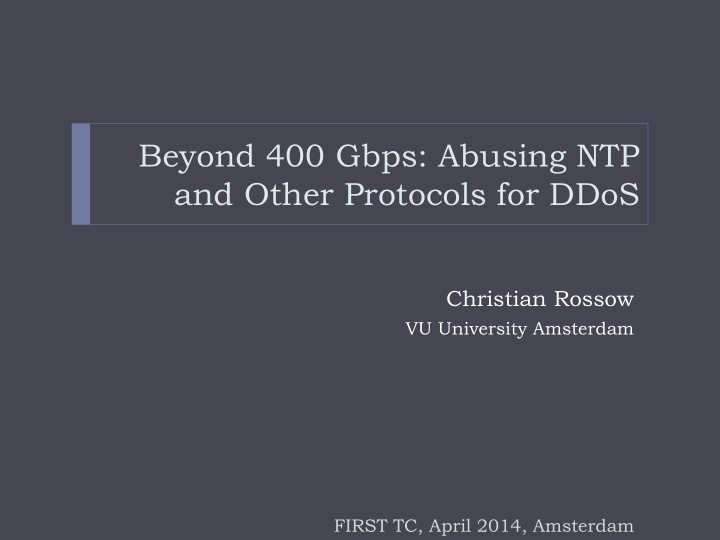



Beyond 400 Gbps: Abusing NTP and Other Protocols for DDoS Christian Rossow VU University Amsterdam FIRST TC, April 2014, Amsterdam
About me: Christian Rossow PostDoc at VU Amsterdam Syssec group of Herbert Bos PostDoc at Ruhr University Bochum Syssec group of Thorsten Holz Other affiliations 2006 – 2013: Institute for Internet Security Internships at ICSI (Berkeley), TU Vienna, Symantec Symantec fellowship award 2013 2
Amplification DDoS Attacks Attacker Victim Amplifier 3
Amplification Attacks in Practice Cloudflare Blog post, February 2014 Cloudflare Blog post, March 2013 4
Attack
14 Network Protocols Vulnerable to Amplificatioon ‘87 ’90 ‘83 2001 ‘99 ‘88 ‘87 ‘99 ‘83 2002 2003 6
Measuring Amplification Rates (1/2) Bandwidth Amplification Factor (BAF) UDP payload bytes at victim UDP payload bytes from attacker Packet Amplification Factor (PAF) # of IP packets at victim # of IP packets from attacker 7
Measuring Amplification Rates (2/2) 1 10 100 1000 10000 SNMP 4670x NTP DNS-NS DNS-OR NetBios SSDP CharGen QOTD 10x BitTorrent Kad Quake 3 15x Steam ZAv2 Sality Gameover 8
Number of Amplifiers 9
Defense
Let’s Play Defense Defensive Countermeasures Attack Detection Attack Filtering Hardening Protocols etc. 11
Attack Detection at the Victim 12
Attack Detection at the Amplifier 13
Attack traffic filtering
Protocol Hardening: DNS Secure your open recursive resolvers Restrict resolver access to your customers See: http://www.team-cymru.org/Services/Resolvers/instructions.html Check your network(s) at http://openresolverproject.org/ Rate-limit at authoritative name servers Response Rate Limiting (RRL) – now also in bind See: http://www.redbarn.org/dns/ratelimits 15
Protocol Hardening: NTP Disable monlist at your NTP servers Add to your ntp.conf: restrict default noquery monlist is optional and not necessary for time sync Check your network(s) at http://openntpproject.org/ Filter monlist response packets UDP source port 123 with IP packet length 468 Only very few (non-killer) monlist legitimate use cases 16
Further Countermeasures S.A.V.E. – Source Address Verification Everywhere a.k.a. BCP38 Spoofing is the root cause for amplification attack Implement proper handshakes in protocols Switch to TCP Re-implement such a handshake in UDP Rate limiting (with limited success)
Conclusion
Conclusion 14+ UDP-based protocols are vulnerable to ampl. We can mitigate individual amplification vectors NTP: Down to 8% of vulnerable servers in 7 weeks DNS: Still 25M open resolvers – let’s close them! S.A.V.E. would kill the problem at its root 19
Acknowledgements Thanks to SURFnet, DFN-CERT, CERT/CC John Kristoff (Team Cymru) Jared Mauch (Open XXX Project.org) Harlan Stenn (NTF) Alfred Reynolds (Valve Software) Marc Kührer (Ruhr-University Bochum) And many others. 20
Beyond 400 Gbps: Abusing NTP and Other Protocols for DDoS Christian Rossow VU University Amsterdam FIRST TC, April 2014, Amsterdam
Recommend
More recommend